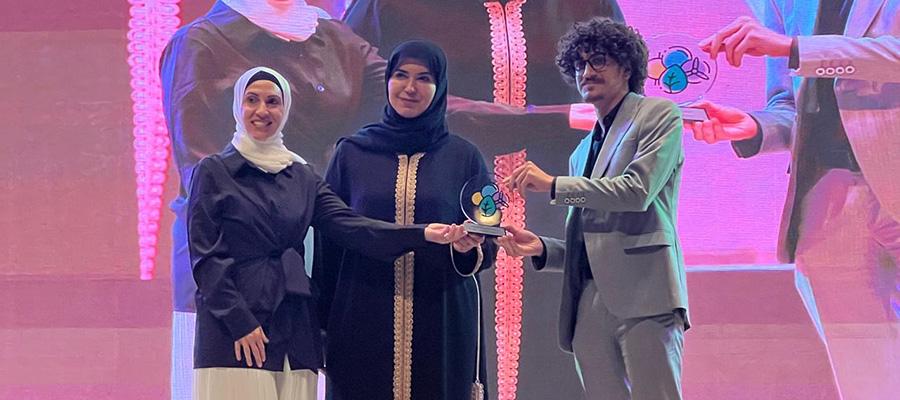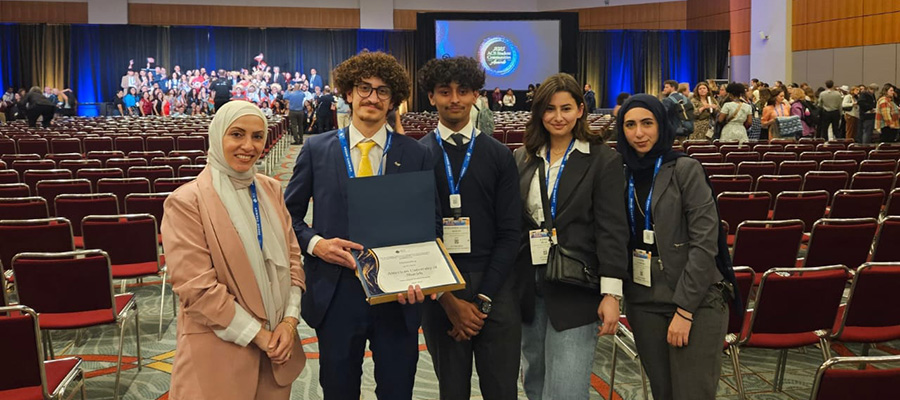- About
- Admissions
- Study at AUS
- Prospective Students
- Bachelor's Degrees
- Master's Degrees
- Doctoral Degrees
- Admission Publications
- International Students
- Contact Admissions
- Grants and Scholarships
- Sponsorship Liaison Services
- Testing Center
- New Undergraduate Student Guide
- Undergraduate Orientation
- New Graduate Student Guide
- Graduate Orientation
- File Completion
- Payment Guide
- Students with Disabilities
- Executive and Continuing Education
- Academics
- Life at AUS
- Research
- Publications
- Contact Us
- Apply Now
- .

CAS project on “forever chemicals” wins second place in the 2025 Sharjah Sustainability Award
A student-faculty led research team from American University of Sharjah’s (AUS) College of Arts and Sciences has been awarded second place in the 2025 Sharjah Sustainability Award for developing a sustainable solution to treat PFAS, also known as “forever chemicals.” The project was selected from among 235 submissions from across the UAE and recognized for its innovative take on tackling persistent environmental pollutants through low-toxicity, light-activated materials.
The research originated during the 16-week Greening with Science, Technology and Innovation (GWSTI) Bootcamp, an initiative by UNESCO IESALC and the United Nations Office for South-South Cooperation, in which AUS was selected to represent the region, joining leading institutions from across the Global South. The research was carried out by environmental sciences student Kareem Mazen and supervised by Dr. Fatin Samara, Dr. Sofian Kanan and Dr. Venkatesh Gopal from the Department of Biology, Chemistry and Environmental Sciences. Their work focused on developing a BiOI/ZnO photocatalyst—a material that uses visible light to break down perfluorooctanoic acid (PFOA), a type of PFAS commonly found in contaminated water.
Mazen said the project was driven by his personal concern about the widespread presence of forever chemicals in the environment: “The idea that certain chemicals can remain in water, soil and even our bodies for decades without breaking down struck me. I felt the drive to explore solutions through science, particularly chemistry, to mitigate these challenges.”
“PFAS are among the most persistent and hazardous contaminants in our modern environments,” added Dr. Samara. “Our team was inspired by the urgent need for more sustainable and effective remediation methods. Our solution provides a low-toxicity, energy-efficient alternative to conventional remediation methods, which are energy-intensive, generate secondary waste or are cost-prohibitive for large-scale use.”

The project benefited from interdisciplinary support through the Sharjah Environmental Hazards Assessment and Remediation (SEHAR) Research Group at AUS.
“This recognition is a proud moment for AUS and highlights the value of collaboration,” said Dr. Samara. “The results we achieved were made possible through open, interdisciplinary teamwork—both within the research group and with the wider Department of Biology, Chemistry and Environmental Sciences at CAS. It also reflects our focus on high-impact, student-driven research that addresses real-world environmental issues.”
Reflecting on why the research stood out among hundreds of submissions, Mazen said: “What I think makes our research impactful is its focus on using a special material consisting of different metal oxides, called BiOI/ZnO, which acts as a catalyst to break down a group of harmful ‘forever chemicals.’”
“This particular material functions by getting ‘activated’ when exposed to visible light, releasing very reactive species that can then attack the pollutant and degrade it. In simple terms, it is akin to using sunlight to clean toxic waste from water.”

Dr. Samara commented on Mazen’s contributions: “What stood out throughout this project was Kareem’s initiative, his boundless curiosity and the time he devoted to refining every stage of the research. He approached the work with professionalism and scientific maturity, and remained committed to sharing his findings beyond the lab. As a result, he was able to present the project at the American Chemical Society (ACS) Spring Conference in San Diego in April 2025, and represented AUS and the region before an international scientific audience. He has been a truly outstanding ambassador of student-led environmental research at AUS.”
Mazen said the experience not only sharpened his technical and communication skills, but also solidified his ambition to pursue graduate studies and a research-focused career in environmental solutions.
“Start with curiosity and don’t be afraid to ask big questions,” he advised fellow students. “Get involved in research early, seek out mentors and stay persistent—even when experiments don’t go as planned. Environmental research is challenging but incredibly fulfilling, because your work can contribute to meaningful change.”
For more information on AUS’ cutting-edge programs in biology, chemistry and environmental sciences, visit www.aus.edu/cas/department-of-biology-chemistry-and-environmental-sciences.

